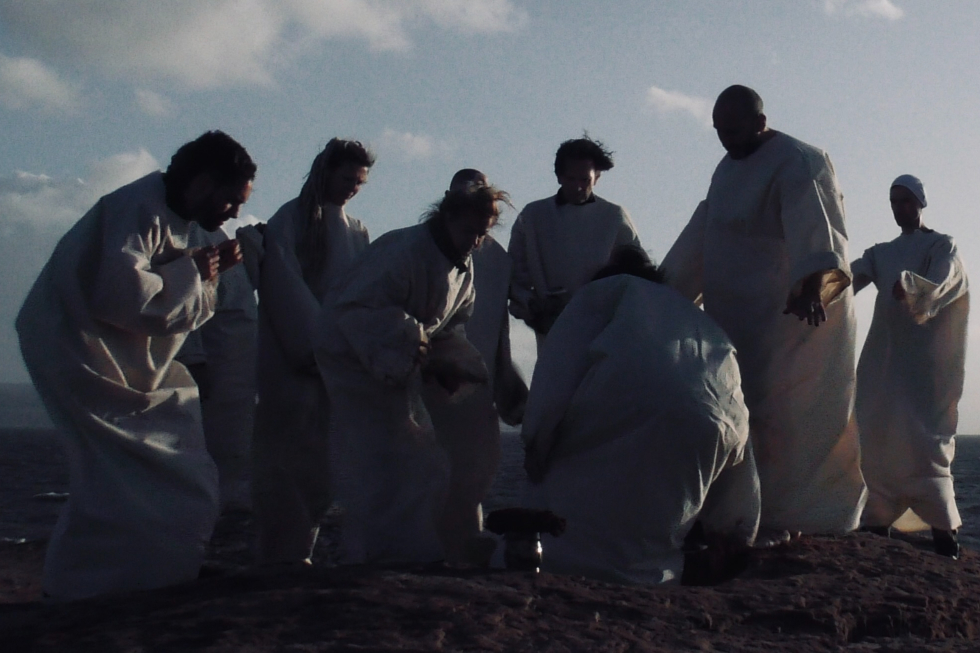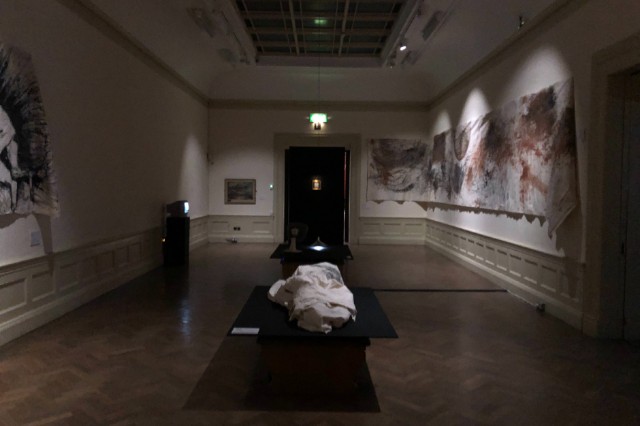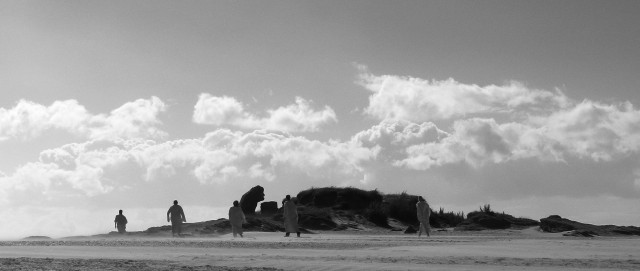Review: Space is the Place: Act 2 – A Transfigured Movement in Time

“The scenes that unfold are mysterious, baffling even.” Lorraine Bacchus gets to grips with psychomagic and ritual at Birkenhead’s Williamson Art Gallery…
A 30-minute artists’ film can be quite a big ask of a viewer’s attention, but this one at the Williamson Gallery is compelling. A Transfigured Movement in Time is the centrepiece of Space is the Place: Act 2, a multi-media collaboration between Patric Rogers and Angelo Madonna – Act 1 having taken place last year at nearby Convenience Gallery. (It should be noted, here, that the work is unrelated to the film of the same name on and about Sun Ra.)
The setting for the film is the Wirral’s uninhabited Hilbre Island. Rogers and Madonna have a long, ongoing relationship with Hilbre, one which they are now exploring through psychogeography; how place influences our emotions and behaviour; and psychomagic, which uses the power of imagination, creativity, symbolism and rituals for inner transformation. The term is new to me, but its influence becomes apparent when watching the film, which features a group of silent performers, dressed in identical full-length robes.
The scenes that unfold are mysterious, baffling even, and yet their apparently unified sense of purpose holds my attention. They march purposefully, or sometimes they stand and stare expectantly or in awe; in other scenes they are absorbed in carrying out what look like choreographed rituals.
At first I had wanted to know more about who they were, to understand why they were there, and what they were doing. But gradually these questions faded in importance, and it became possible to accept that something beyond literal meaning was being enacted. I stopped imposing my long-lapsed, but ingrained, Catholic upbringing on the film’s rituals; questions of a more personal nature arose – not least, why I had never been to Hilbre. It also set me thinking about the trust required to engage in collective acts of humility and to wonder what is the glue that holds a secular society together, or whether there is one at all.

One of the performers, artist John Elcock, explained to me that nothing had been scripted, that some were strangers to each other, and that they were guided, rather than instructed, to engage with the island and its ancient landscape. He described it as a positive and transformative experience that was deeply affecting, as they became completely immersed in their actions and surroundings.
Visitors to this exhibition will first encounter a gallery of intriguing, but seemingly unrelated and disparate works. Their relevance and inter-connectedness only becoming apparent on seeing the film. Dominating the walls are two large fabric hangings. One is a black and red-oxide abstract painting, punctuated by imprints of hands. Reminiscent of Neolithic cave art, it is made in the film during a collaborative, immersive act of mark-making by the performers.
The other hanging depicts outlines of prone figures, made when the performers drew in charcoal around some of their group, seemingly resting after their experiences. Until I saw the film and understood something of its significance, this piece made me think of a mass crime scene. But perhaps I’ve seen too many Scandi-Noir dramas.
The other exhibits are evocations of the island and the artists’ related ideas. They include sound installations, a short dream film, a printout of a poem echoed in the film, and, right at the end, a solitary traditional framed oil painting from the Williamson’s permanent collection. Hilbre Island and Low Tide by Millicent Emily Ayrton (1913-2000) loops back in time as a poignant echo of Hilbre’s presence and inspiration to artists then and now.

I found Madonna’s sound installations, Tide Comes In/Tide Goes Out, to be particularly poignant. The artist has connected an old piano soundboard to hardware encoded with the data of Hilbre’s tide table. The result is the metronomic playing of a single, plaintiff piano note that punctuates the gallery at intervals, a sonic reminder of the unceasing natural rhythms of the world in which we live. Hilbre Island is about eight miles from the Williamson; with this piece its tidal ebb and flow is palpable.
Space is the Place pays homage to Hilbre, born in particular out of Rogers’ gratitude to how it sustained him during the long pandemic months. He experienced what its overwintering birds have long known: that Hilbre is a most vital safe haven.
“Art looks like an object but it isn’t one; it’s a process, a happening, an event, an experience” said author, Jeanette Winterson. This sentiment epitomises the exhibition and what brought it into being. In exploring the concepts of psychogeography and psychomagic, the artists hope it will be a trigger for viewers to ponder how we connect to the landscapes we inhabit. It’s a thought-provoking experience.
Lorraine Bacchus
See Space is the Place: Act 2 – A Transfigured Movement in Time @ Williamson Art Gallery until 29 October 2022, FREE
See a screening of the film, A Transfigured Movement in Time, followed by a Q&A with artists Patric Rogers and Angelo Madonna, Friday 21 October 2022, 6.30pm, FREE
All images courtesy the artists





